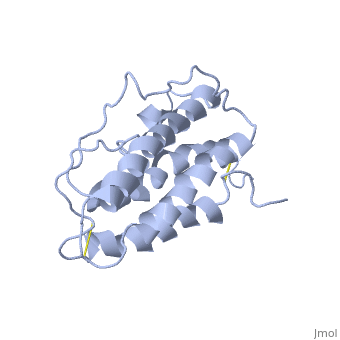|
|
| (One intermediate revision not shown.) |
| Line 1: |
Line 1: |
| | | | |
| | ==HUMAN ERYTHROPOIETIN, NMR MINIMIZED AVERAGE STRUCTURE== | | ==HUMAN ERYTHROPOIETIN, NMR MINIMIZED AVERAGE STRUCTURE== |
| - | <StructureSection load='1buy' size='340' side='right'caption='[[1buy]], [[NMR_Ensembles_of_Models | 1 NMR models]]' scene=''> | + | <StructureSection load='1buy' size='340' side='right'caption='[[1buy]]' scene=''> |
| | == Structural highlights == | | == Structural highlights == |
| - | <table><tr><td colspan='2'>[[1buy]] is a 1 chain structure with sequence from [http://en.wikipedia.org/wiki/Human Human]. Full experimental information is available from [http://oca.weizmann.ac.il/oca-bin/ocashort?id=1BUY OCA]. For a <b>guided tour on the structure components</b> use [http://oca.weizmann.ac.il/oca-docs/fgij/fg.htm?mol=1BUY FirstGlance]. <br> | + | <table><tr><td colspan='2'>[[1buy]] is a 1 chain structure with sequence from [https://en.wikipedia.org/wiki/Homo_sapiens Homo sapiens]. Full experimental information is available from [http://oca.weizmann.ac.il/oca-bin/ocashort?id=1BUY OCA]. For a <b>guided tour on the structure components</b> use [https://proteopedia.org/fgij/fg.htm?mol=1BUY FirstGlance]. <br> |
| - | </td></tr><tr id='resources'><td class="sblockLbl"><b>Resources:</b></td><td class="sblockDat"><span class='plainlinks'>[http://oca.weizmann.ac.il/oca-docs/fgij/fg.htm?mol=1buy FirstGlance], [http://oca.weizmann.ac.il/oca-bin/ocaids?id=1buy OCA], [http://pdbe.org/1buy PDBe], [http://www.rcsb.org/pdb/explore.do?structureId=1buy RCSB], [http://www.ebi.ac.uk/pdbsum/1buy PDBsum], [http://prosat.h-its.org/prosat/prosatexe?pdbcode=1buy ProSAT]</span></td></tr> | + | </td></tr><tr id='method'><td class="sblockLbl"><b>[[Empirical_models|Method:]]</b></td><td class="sblockDat" id="methodDat">Solution NMR</td></tr> |
| | + | <tr id='resources'><td class="sblockLbl"><b>Resources:</b></td><td class="sblockDat"><span class='plainlinks'>[https://proteopedia.org/fgij/fg.htm?mol=1buy FirstGlance], [http://oca.weizmann.ac.il/oca-bin/ocaids?id=1buy OCA], [https://pdbe.org/1buy PDBe], [https://www.rcsb.org/pdb/explore.do?structureId=1buy RCSB], [https://www.ebi.ac.uk/pdbsum/1buy PDBsum], [https://prosat.h-its.org/prosat/prosatexe?pdbcode=1buy ProSAT]</span></td></tr> |
| | </table> | | </table> |
| | == Disease == | | == Disease == |
| - | [[http://www.uniprot.org/uniprot/EPO_HUMAN EPO_HUMAN]] Genetic variation in EPO is associated with susceptbility to microvascular complications of diabetes type 2 (MVCD2) [MIM:[http://omim.org/entry/612623 612623]]. These are pathological conditions that develop in numerous tissues and organs as a consequence of diabetes mellitus. They include diabetic retinopathy, diabetic nephropathy leading to end-stage renal disease, and diabetic neuropathy. Diabetic retinopathy remains the major cause of new-onset blindness among diabetic adults. It is characterized by vascular permeability and increased tissue ischemia and angiogenesis. | + | [https://www.uniprot.org/uniprot/EPO_HUMAN EPO_HUMAN] Genetic variation in EPO is associated with susceptbility to microvascular complications of diabetes type 2 (MVCD2) [MIM:[https://omim.org/entry/612623 612623]. These are pathological conditions that develop in numerous tissues and organs as a consequence of diabetes mellitus. They include diabetic retinopathy, diabetic nephropathy leading to end-stage renal disease, and diabetic neuropathy. Diabetic retinopathy remains the major cause of new-onset blindness among diabetic adults. It is characterized by vascular permeability and increased tissue ischemia and angiogenesis. |
| | == Function == | | == Function == |
| - | [[http://www.uniprot.org/uniprot/EPO_HUMAN EPO_HUMAN]] Erythropoietin is the principal hormone involved in the regulation of erythrocyte differentiation and the maintenance of a physiological level of circulating erythrocyte mass. | + | [https://www.uniprot.org/uniprot/EPO_HUMAN EPO_HUMAN] Erythropoietin is the principal hormone involved in the regulation of erythrocyte differentiation and the maintenance of a physiological level of circulating erythrocyte mass. |
| | == Evolutionary Conservation == | | == Evolutionary Conservation == |
| | [[Image:Consurf_key_small.gif|200px|right]] | | [[Image:Consurf_key_small.gif|200px|right]] |
| Line 36: |
Line 37: |
| | __TOC__ | | __TOC__ |
| | </StructureSection> | | </StructureSection> |
| - | [[Category: Human]] | + | [[Category: Homo sapiens]] |
| | [[Category: Large Structures]] | | [[Category: Large Structures]] |
| - | [[Category: Aoki, K H]] | + | [[Category: Aoki KH]] |
| - | [[Category: Cheetham, J C]] | + | [[Category: Cheetham JC]] |
| - | [[Category: Egrie, J]] | + | [[Category: Egrie J]] |
| - | [[Category: Harvey, T S]] | + | [[Category: Harvey TS]] |
| - | [[Category: Hoeffel, T J]] | + | [[Category: Hoeffel TJ]] |
| - | [[Category: Smith, D M]] | + | [[Category: Smith DM]] |
| - | [[Category: Stevenson, J L]] | + | [[Category: Stevenson JL]] |
| - | [[Category: Syed, R S]] | + | [[Category: Syed RS]] |
| - | [[Category: Cytokine]]
| + | |
| - | [[Category: Glycoprotein]]
| + | |
| - | [[Category: Growth factor]]
| + | |
| Structural highlights
Disease
EPO_HUMAN Genetic variation in EPO is associated with susceptbility to microvascular complications of diabetes type 2 (MVCD2) [MIM:612623. These are pathological conditions that develop in numerous tissues and organs as a consequence of diabetes mellitus. They include diabetic retinopathy, diabetic nephropathy leading to end-stage renal disease, and diabetic neuropathy. Diabetic retinopathy remains the major cause of new-onset blindness among diabetic adults. It is characterized by vascular permeability and increased tissue ischemia and angiogenesis.
Function
EPO_HUMAN Erythropoietin is the principal hormone involved in the regulation of erythrocyte differentiation and the maintenance of a physiological level of circulating erythrocyte mass.
Evolutionary Conservation
Check, as determined by ConSurfDB. You may read the explanation of the method and the full data available from ConSurf.
Publication Abstract from PubMed
The solution structure of human erythropoietin (EPO) has been determined by nuclear magnetic resonance spectroscopy and the overall topology of the protein is revealed as a novel combination of features taken from both the long-chain and short-chain families of hematopoietic growth factors. Using the structure and data from mutagenesis studies we have elucidated the key physiochemical properties defining each of the two receptor binding sites on the EPO protein. A comparison of the NMR structure of the free EPO ligand to the receptor bound form, determined by X-ray crystallography, reveals conformational changes that may accompany receptor binding.
NMR structure of human erythropoietin and a comparison with its receptor bound conformation.,Cheetham JC, Smith DM, Aoki KH, Stevenson JL, Hoeffel TJ, Syed RS, Egrie J, Harvey TS Nat Struct Biol. 1998 Oct;5(10):861-6. PMID:9783743[1]
From MEDLINE®/PubMed®, a database of the U.S. National Library of Medicine.
See Also
References
- ↑ Cheetham JC, Smith DM, Aoki KH, Stevenson JL, Hoeffel TJ, Syed RS, Egrie J, Harvey TS. NMR structure of human erythropoietin and a comparison with its receptor bound conformation. Nat Struct Biol. 1998 Oct;5(10):861-6. PMID:9783743 doi:10.1038/2302
|


